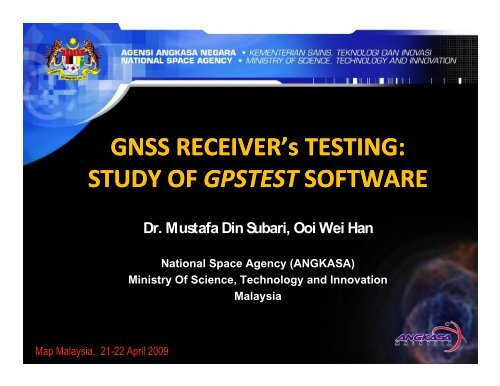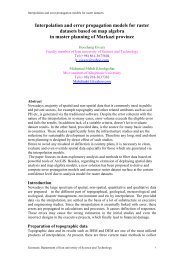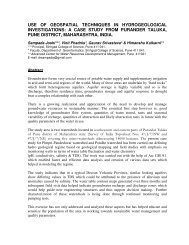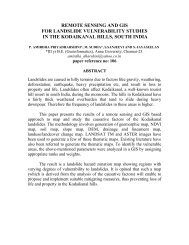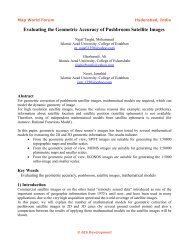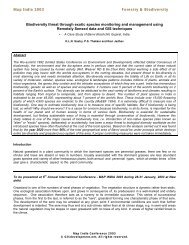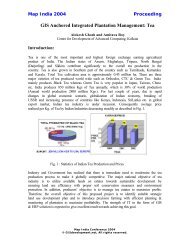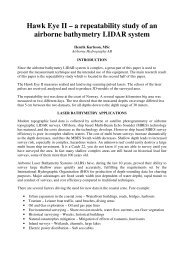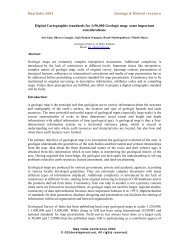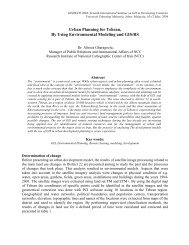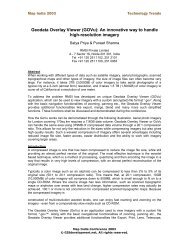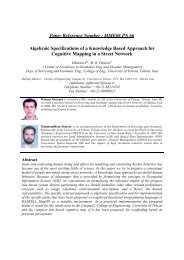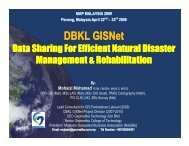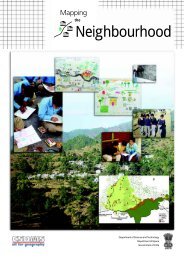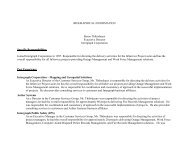Dr. Mustafa Din Subari, Ooi Wei Han
Dr. Mustafa Din Subari, Ooi Wei Han
Dr. Mustafa Din Subari, Ooi Wei Han
Create successful ePaper yourself
Turn your PDF publications into a flip-book with our unique Google optimized e-Paper software.
Map Malaysia, 21-22 April 2009<br />
<strong>Dr</strong>. <strong>Mustafa</strong> <strong>Din</strong> <strong>Subari</strong>, <strong>Ooi</strong> <strong>Wei</strong> <strong>Han</strong><br />
National Space Agency (ANGKASA)<br />
Ministry Of Science, Technology and Innovation<br />
Malaysia
• Introduction<br />
• Objectives<br />
• Current GNSS Tests and Test Centers<br />
• The Need of Testing<br />
• GPSTest software and Capabilities<br />
• Test 1, 2 and 3<br />
• Results and Analysis<br />
• Conclusions
1. Global Navigation Satellite System (GNSS) becoming a<br />
global utility used in various applications.<br />
2. Current GNSS:<br />
- GPS modernization (USA)<br />
- Galileo (Europe)<br />
- GLONASS (Russian)<br />
- QZSS (Japan)<br />
- Compass (China)<br />
3. Applications:<br />
Navigation, LBS, Positioning, Surveying and Mapping,<br />
Military, and etc.
4. Multiple types of GNSS receivers:<br />
- Accuracy from few centimeter to meter<br />
- NMEA 0183 standard outputs<br />
- RINEX standard outputs<br />
5. Various tests and studies:<br />
- ensure better accuracy in all conditions and<br />
environments.<br />
6. GPSTest Software:<br />
- Testing and evaluating NMEA standard receivers.<br />
- Help the users understand the quality, stability,<br />
performance and accuracy.
To discuss on effectiveness of GPSTest for GNSS navigation<br />
receivers (NMEA output).<br />
To determine the performance and accuracy achievement<br />
by several type of navigation receivers.<br />
To implement this test procedures for navigation sectors<br />
in Malaysia to ensure safe and accurate use of local<br />
GNSS receivers.
1. Surveying sector:<br />
- Zero Baseline Test<br />
- EDM Baseline Test<br />
- GPS Network Test<br />
2. Industry sectors:<br />
- Environmental Test<br />
- Electromagnetic Interference Test<br />
- Vulnerability Field Test<br />
- Receiver timing measurement<br />
- Space and Ground Receiver Evaluation<br />
- Flight Test<br />
- Mobile Test<br />
- Notice Advisory to Navstar Users (NANU)<br />
- and etc.
THE NEED OF TESTING<br />
GNSS NAVIGATION RECEIVERS<br />
Sectors Types Accuracy Required (m)<br />
Land Vehicle Navigation 2 – 5<br />
Personnel Navigation 2 – 10<br />
Emergency 5 – 20<br />
Marine Harbor 5 – 20<br />
Inland Waterways 8 – 20<br />
Coastal 20 – 100<br />
Aviation Landing (position) 5 – 20<br />
Landing (height) 0.5 – 5<br />
En route > 100<br />
Source: Book of “Navigation: Principles of Positioning and Guidance”, by Bernhard Hofmann et.al.<br />
Book of “GPS Theory and Applications Volume 2”, by Parkinson et. al. al.
Sept 2008
The current GNSS tests are concentrated on interference<br />
of radio frequency signal (RF).<br />
- Standard and Industrial Research Institute of<br />
Malaysia (SIRIM) only tests onto the signal<br />
interference.<br />
- Doesn’t test on the spatial accuracy especially<br />
the reliability of location points.<br />
- Prove the accuracy range value of every times<br />
measurement is not much different.
• Tool for testing and evaluating GNSS navigation<br />
receivers based on the NMEA 0183 standard.<br />
• Help to understand and evaluate the quality,<br />
stability and accuracy of navigation receivers.<br />
• Capability to carried out several parameter<br />
performances of receivers.<br />
• Compare the quality and performances of different<br />
navigation receivers.
1: 1: Log Log and and Monitor Monitor NMEA NMEA data data<br />
• NMEA messages, navigation info, signal quality and satellites in view.<br />
• Monitor and compare on performances among different receivers.
2: Time To First Fix (TTFF)<br />
• Cold, warm, hot start time test results.
3: Positioning Accuracy Analysis<br />
• Get different accuracy estimation of receivers.<br />
- known coordinate<br />
- mathematic mean<br />
- model mean<br />
• Giving an error rejection<br />
probability.
• Positioning Accuracy in<br />
Graphical View.<br />
• Accuracy Estimation Results
4: Outlier Analysis<br />
• List all the rejected errors for further analysis.
5: Report Evaluation Results<br />
• Error Distribution in Latitude, Longitude and Altitude Direction
i. Haicom GPS, HI-204III – s/n: 305 and 306<br />
ii. Navisys GPS, GR-101 – s/n: 555<br />
iii. HTC PDA Phone - TyTn II<br />
iv. Samsung Samsung PDA PDA Phone - SGH-i780
• To determine efficacy of navigation receivers.<br />
• Comparing the TTFF / cold start time and accuracy<br />
with manufacturer’s specifications.<br />
• Every receiver has to collect 15 minutes or almost<br />
900 points positioning of NMEA data in static mode.<br />
• Three (3) epoch’s observations at the field.<br />
• Result of the test is showed in following.
All in well conditions.
Test 2 – Evaluation between similar receiver’s type or brand<br />
• To find out the better performances and outputs<br />
among the same type or brand of receivers.<br />
• Haicom 305 and 306 306; 306 306; HTC and SGH GPS PDA.<br />
• Each pair of receivers logging 15 min NMEA data<br />
simultaneously.<br />
• Two (2) epoch observations at the same location.<br />
• Results and comparison on Horizontal Positioning,<br />
• Results and comparison on Horizontal Positioning,<br />
HPE (X,Y) and Altitude (Z) errors are showed.
Haicom s/n 305 and 306 – Epoch 1
Haicom s/n 305 and 306 – Epoch 2
SGH and HTC PDA – Epoch 1
SGH and HTC PDA – Epoch 2
Test 3 – Evaluation between dissimilar receiver’s type or brand<br />
• To compare the performance of dissimilar receiver’s<br />
type.<br />
• Two best receivers in the Test 2, Haicom 305 and<br />
Samsung SGH-i780, and Navisys 555.<br />
• 15 minutes field observations simultaneously.<br />
• Results and comparison on Horizontal Positioning,<br />
• Results and comparison on Horizontal Positioning,<br />
HPE (X,Y) and Altitude (Z) errors are showed.
SGH, Haicom 305 and Navisys 555
• GNSS has been widely used in various applications in Malaysia<br />
since the past few years.<br />
• GNSS navigation receivers are turn into cheaper in selling<br />
price and therefore generate a large volume of users yearly.<br />
• However, the performance and accuracy achieved by<br />
receivers has to be concerned seriously.<br />
• Based on the several test results, GPSTest is proved that<br />
capable for ensuring the higher quality of GNSS receivers likes<br />
Samsung GPS PDA phone.<br />
• Has to be practiced to entire navigation receiver and<br />
beneficial the users in Malaysia.
• More tests on the current or new receivers to<br />
continuously prove the capability of the GPSTest.<br />
• Test on Road Track accuracy.


